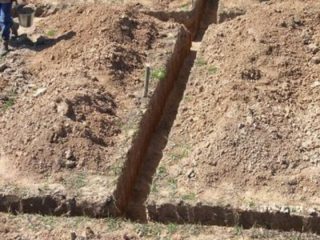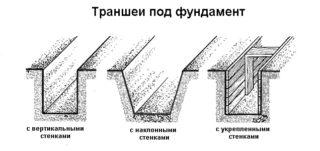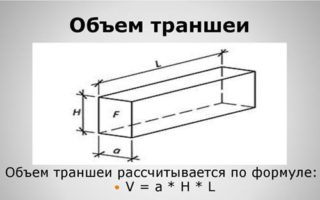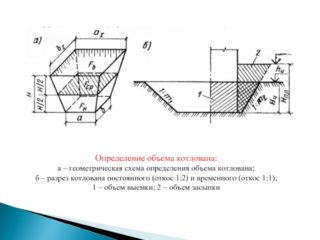The need to prepare a trench arises when laying communications, pipelines, building a foundation. Calculations of the volume of the trench allow you to determine the cost of work, the amount of concrete or other materials to fill the excavation, the volume of soil removed and backfill.
Definition of a trench

A trench is an open cut in the ground, the depth and width of which depends on the purpose for which it is intended. These parameters are determined by building codes and regulations:
- The strip foundation trench should be 60 cm wider than the base. This makes it more convenient to carry out related work. The depth, according to SNiP 3.02.01-87, can vary from 0.5 to 2.5 m.
- A trench is prepared for the gas pipeline with a depth of at least 0.8 m to the surface of the pipe. This rule is enshrined in SNiP 42-01-2002.
- Water pipes are laid below the freezing depth, and at least 0.5 m is added to this value. The depth of the bookmark is regulated by SNiP 2.04.02-84.
- A recess of at least 0.7 m is prepared for the sewage system - for warm regions or more - for areas with severe winters.
- A trench with a depth of 70 cm is sufficient for laying the cable route.
Since earthworks involve physical and financial costs, it is sometimes more expedient to make a shallower trench and insulate the pipe or foundation, and organize drainage.
Trench digging methods

There are three ways to dig a trench:
- manually;
- using a hand trencher;
- trench excavator.
In the first case, the time and physical costs will be significant, and they depend on the quality of the soil in a given area. If it is gritty, digging is greatly facilitated. Clay and stony soils make work difficult. With a hand trencher, work will go faster. But it is most convenient to dig a trench with an excavator, because you do not need to apply physical force. However, the technique can only be used in areas with free access. Moreover, the size of the bucket is selected according to the width of the trench.
The use of technical means is advisable when the volume of work is large.
What affects the volume count
Trenches are prepared during the construction of public and industrial buildings. Payment methods differ depending on the key reasons:
- scope of work;
- the purpose of the construction site;
- topographic features;
- soil composition;
- method of digging a trench;
- the method of land removal (if the removal is carried out by a machine, additional entrances to the site must be provided);
- building density in the neighborhood.
The work can be divided into three stages: development of the plan, digging, arrangement.
Research for volume calculations

In case of self-construction, approximate calculations are made. But if the work is carried out by a specialized organization, studies are carried out to accurately calculate how many cubic meters of earth will be removed when digging a trench, and to correctly determine the volume and cost of the work.
To begin with, a topographic survey is performed to find out the height of the soil, the presence and relative size of drops, and so on. Then cameral processing of information is carried out in order to establish additional points for a more accurate display of values. Based on the research results, a report is drawn up, in accordance with it, the cost of the work is determined.
Trench parameters are set at the planning stage. To prevent the walls of the excavation from collapsing, it is necessary to pay attention to the depth of the trench, its length, and the density of the earth.In case of non-compliance with the SNiP recommendations, an increase in the risk of injuries and collapses is possible.
Calculation of the volume of the trench
- Length - depends on the purpose of the trench.
- Width. This parameter is measured at the bottom and at the top, if the expansion is made closer to the surface. In the latter case, they talk about a trench with slopes and use formulas to take this feature into account.
You can determine the width and length of the trench to calculate its volume yourself using special formulas. Often, this process does not require special precision. But if there is a need for accurate calculations, it is convenient to use construction calculators. It is enough to indicate the known data: the length and width of the trench at the surface, the length and width along the bottom, the depth of the excavation.
No slopes
To calculate the volume of the trench, you need to know the length, width and depth of the excavation, which are indicated as follows:
- a - width in m;
- H - height in m;
- L - length in m.
The volume of the trench is calculated by the formulaV = a × H × L, i.e. if the width of the trench is 1 m, the depth is 1.5 m, and the length is 12 m, then V = 1 × 1.5 × 12 = 18 m³.
Another option for a trench is with vertical walls and a vertical drop. In this case, in addition to the width and length, it is necessary to know the depth of the trench - H1 and the depth of the trench H2.
The formula for calculating the volume is as follows:V = a × (H1 + H2) / 2 × L.
Let be H1 = 1.3 m, H2 = 1.6 m, a = 1 m, L = 12 mthen V = 1 × (1.3 + 1.6) / 2 × 12 = 17.4 m³.
With slopes
- L - trench length, m;
- H - trench depth, m;
- a1 - base width, m;
- a2 - top width, m
The coefficient (m) depends on the type of soil, which is substituted into the formula, since the width of the top of the trench is determined by this parameter. The table shows the coefficients for different soils.
| Soil type | Coefficient m |
| Bulk unconsolidated | 1 |
| Sandy and gravel | 1 |
| Sandy loam | 0,67 |
| Loam | 0,5 |
| Clay | 0,25 |
| Loess and loess-like | 0,5 |
To calculate the width of the top of the groove, you need to use the formulaa2 = H × m + a1 + H × m.
Let be a1 = 1 m, trench height H = 1.5 m, and the soil is clay, then a2 = 1.5 × 0.25 + 1 + 1.5 × 0.25 = 1.75 m
Further, the volume of the trench dug on level ground is calculated by the formulaV = (a1 + a2) / 2 × H × L
If we take, for example, L = 12 m, it will turn outV = (1 + 1.75) / 2 × 1.5 × 12 = 24.75 m³
You can substitute your parameter a2 directly into the formula for calculating the volume.
The most complex calculations will be required to calculate the volume of a trench with slopes in terrain with a height difference. The designations are introduced:
- a1 - width of the base of the notch, m;
- a2 - top width at the lowest point, m;
- a3 - top width at the highest point, m.
Parameters a2 and a3 are calculated using the already known formula. But you also need to know the heights of H1 and H2, respectively. H1 let it be 1.5 m, but H2 = 2.5, a1 = 1 m, soil - clay. First it is determined a2, and then a3:
a2 = H1 × m + a1 + H1 × m = 1.5 × 0.25 + 1 + 1.5 × 0.25 = 1.75 m
a3 = H2 × m + a1 + H2 × m = 2.5 × 0.25 + 1 + 2.5 × 0.25 = 2.25 m
Among other things, to calculate the volume, you need to calculate the cross-sectional area of the cut for the low-lying area and high-rise - F1 and F2, respectively.
F1 = (a1 + a2) / 2 × H1 = (1 + 1.75) / 2 × 1.5 = 2.0625 m2
F2 = (a1 + a3) / 2 × H2 = (1 + 2.25) / 2 × 2.5 = 4.0625 m2
We will accept L = 12 m, take the soil coefficient for clay m = 0.25 and calculate the volume of the excavation, taking into account the calculated parameters:
V = (F1 / 2 + F2 / 2-m × (H1-H2) 2/6) × L = (2.0625 / 2 + 4.0625 / 2-0.25 × (1.5-2.5 ) 2/6) × 12 = 36.25 m³
Calculation of the volume of the pit
The calculation of the volume of a pit with rectangular walls is performed in accordance with the mathematical formula for calculating the volume of a rectangle. Need to know H - pit depth, L1 - length in m and L2 - width in m.
The calculation is carried out according to the formula V = L1 × L2 × H
If a H = 2 m, L1 = 3 m, L2 = 4 m, then V = 3 × 4 × 2 = 24 m³
This formula is correct if the depth of the pit is the same at all points.
For a rectangular pit with vertical walls, dug in terrain with a difference in elevation, you need to use a different formula and measure the depth in each corner, respectively H1, H2, H3 and H4.
Let be H1 = 2m, H2 = 2.5m, H3 = 2.5m, H4 = 3m, L1 and L2, as in the previous example, then:
V = L1 × L2 × (H1 + H2 + H3 + H4) / 4 = 3 × 4 × (2 + 2.5 + 2.5 + 3) / 4 = 30 m3
To calculate the volume of a pit with slopes dug on level ground, the formula is applied V = (H / 6 × ((2 × L1 + L3) × L2 + (2 × L3 + L1) × L4)... In addition to L1 and L2 - the length and width of the base, you need to know L3 and L4 - the length and width of the pit at the surface. You can calculate these values using the formulas:
L3 = H × m + L1 + H × m and L4 = H × m + L2 + H × mwhere m - coefficient depending on the type of soil.
Let the soil be loam, L1 = 3 m, L2 = 4 m, H = 2 m, then:
L3 = 2 × 0.5 + 3 + 2 × 0.5 = 5 m,
L4 = 2 × 0.5 + 4 + 2 × 0.5 = 6 m.
We substitute the values into the formula that allows us to calculate the amount of earthwork:
V = (2/6 × ((2 × 3 + 5) × 4 + (2 × 5 + 3) × 6 = 40.667 m³
If the recess is dug in the form of a well, to calculate the pit, you need to know the diameter of the base - d1, surface diameter - d2 and height - H.
V = 3.14 × ((d1 + d2 / 2) 2/4 × H
If we take as an example d1 = 1.5 m, but d2 = 2.5 m, H = 3 mthen V = 3.14 × ((1.5 + 2.5) / 2) 2/4 × 3 = 3.14 × 22/4 × 3 = 9.42 m³.












